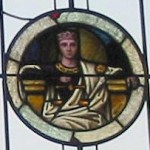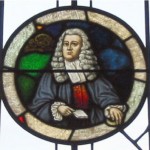Art History Mystery, Part 2
 In the previous post, I detailed how the figure to the left of Moses must be Sir William Blackstone. I had thought that the figure to the right of Moses was King Solomon. The iconography of the throne, crown, royal purple, and scales all point to Solomon. However, this figure is beardless, and artists have traditionally depicted Solomon as a bearded, often old, king (see, e.g., a ninth-century German illuminated Bible, and Renaissance depictions such as the panel of Solomon meeting the Queen of Sheba panel from Ghiberti’s famed “Golden Doors” of the Florentine Baptistry, and also the fresco by Piero della Fransceca in Arezzo). On the other hand, artists from later centuries did portray the famous ruler as clean-shaven (see, e.g., this 18th-century Russian icon, and an engraving by the 19th-century master Gustav Doré).
In the previous post, I detailed how the figure to the left of Moses must be Sir William Blackstone. I had thought that the figure to the right of Moses was King Solomon. The iconography of the throne, crown, royal purple, and scales all point to Solomon. However, this figure is beardless, and artists have traditionally depicted Solomon as a bearded, often old, king (see, e.g., a ninth-century German illuminated Bible, and Renaissance depictions such as the panel of Solomon meeting the Queen of Sheba panel from Ghiberti’s famed “Golden Doors” of the Florentine Baptistry, and also the fresco by Piero della Fransceca in Arezzo). On the other hand, artists from later centuries did portray the famous ruler as clean-shaven (see, e.g., this 18th-century Russian icon, and an engraving by the 19th-century master Gustav Doré).
However, noticeably absent from the stained glass was any iconography of a sword (cf. ‘splitting the baby’ from 1 Kings 3:16-28). A fellow law student held that the figure was really King David.
One authority, though, holds that the figure is neither David nor Solomon. During his spring 2008 visit to the law school, Judge Pryor of the US Court of Appeals for the Eleventh Circuit, who had identified Blackstone, offered Lady Justice as the likely candidate. This would account for the beardlessness, and the classic imagery of the scales is present. However, absent are the iconic sword and blindfold, and Lady Justice usually is not crowned. It’s a tough call. I welcome feedback to solve this art history mystery….

 As I have always loved stained glass windows, one of my favorite locations in the law school is Eisenberg Hall. However, the trio of figures in the north set of windows bear no label, so I was curious about their exact identity. The center figure holding the stone tablets of the Law is of course Moses. Following this Biblical theme of lawgivers, I surmised that the figure to the right (as one looks at Moses) seated on the throne was King Solomon (more on the next blog post). I also guessed that the figure to the left, in the judicial wig, was likely the 18th century jurist
As I have always loved stained glass windows, one of my favorite locations in the law school is Eisenberg Hall. However, the trio of figures in the north set of windows bear no label, so I was curious about their exact identity. The center figure holding the stone tablets of the Law is of course Moses. Following this Biblical theme of lawgivers, I surmised that the figure to the right (as one looks at Moses) seated on the throne was King Solomon (more on the next blog post). I also guessed that the figure to the left, in the judicial wig, was likely the 18th century jurist 